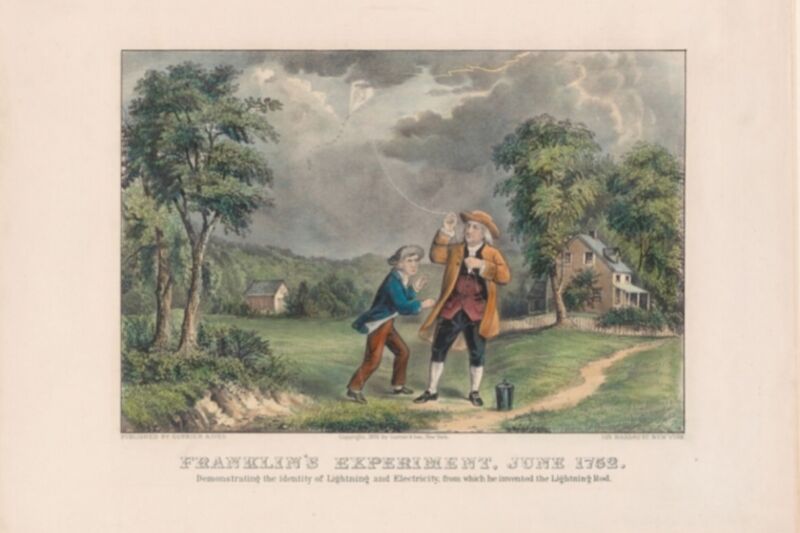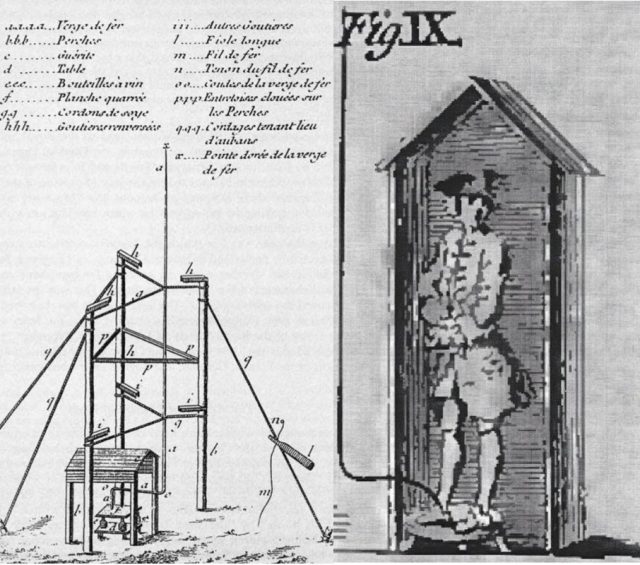
Public domain
Most Americans are familiar with the story of Benjamin Franklin and his famous 18th century experiment in which he attached a metal key to a kite during a thunderstorm to see if the lightning would pass through the metal. That’s largely due to many iconic illustrations commemorating the event that found their way into the popular imagination and became part of our shared cultural lore. But most of those classic illustrations are riddled with historical errors, according to a new paper published in the journal Science and Education.
Franklin’s explorations into electricity began as he was approaching 40 years old after his thriving career as an entrepreneur in the printing business. His scientific interest was piqued in 1743 when he saw a demonstration by scientist/showman Archibald Spencer, known for performing various amusing parlor tricks involving electricity. He soon started a correspondence with a British botanist named Peter Collinson and began reproducing some of Spencer’s impressive parlor tricks in his own home.
He would have guests rub a tube to create static and then have them kiss, producing an electrical shock. He designed a fake spider suspended by two electrified wires so that it seemed to swing back and forth of its own accord. And he devised a game dubbed “Treason,” whereby he wired up a portrait of King George so that anyone who touched the monarch’s crown would be shocked. And he once infamously shocked himself while trying to kill a turkey with electricity.
Among his many insights into the phenomenon, Franklin noted how sparks jumped between objects and concluded that lightning was merely a massive electric spark, similar to those produced from charged Leyden jars. To test his theory about the nature of lightning, Franklin published a paper proposing an experiment with an elevated iron rod wire to “draw down the electric fire” from a cloud, with the experimenter standing on insulated ground in the protection of an enclosure similar to a soldier’s sentry box. Franklin reasoned that an electrified cloud passing over the pointed rod would pull electricity from the cloud, such that if the man moved the knuckle of his finger closer to the metal rod, there should be sparks.
There’s no record of Franklin performing his sentry-box experiment, per Breno Arsioli Moura, a science history and educator at the Federal University of the ABC in Brazil, who authored the new paper. But a Frenchman named Thomas-Francois D’Alibard did. D’Alibard read Franklin’s published paper and used a 50-foot-long vertical rod to perform his version of the sentry-box experiment in Paris on May 10, 1752. Others across Europe soon followed suit. It was a rather dangerous experiment, as evidenced by the unfortunate Georg Wilhelm Reichmann. He also attempted to reproduce the experiment, but a glowing ball of charge traveled down the string, jumped to his forehead, and killed him instantly—perhaps the first documented instance of ball lightning.

Public domain
It seems Franklin didn’t know about these attempts when he devised his simpler kite experiment along similar conceptual lines. The established account goes something like this: Anticipating a thunderstorm in June 1752, on the outskirts of Philadelphia, Franklin built a kite out of two strips of cedar nailed together in the shape of a cross or “X,” with a large silk handkerchief forming the body, since silk could withstand the wet and wind of a thunderstorm. He attached a wire to the top of the kite to serve as a makeshift lightning rod. Hemp string was attached to the bottom of the kite to provide conductivity and attached to a Leyden jar by a thin metal wire. Also attached to the hemp was a silk string held by Franklin. Joining the hemp and silk strings was a metal key.
Next, Franklin stood under a shed roof to ensure he held a dry portion of the silk string to keep it from becoming conductive. Franklin’s son, then 21, assisted him in raising the kite, and they settled down to wait. Eventually, Franklin observed the loose filaments of twine “stand erect,” indicating electrification. He pressed his knuckle to the key and was rewarded with an electric spark. This proved that lightning was static electricity. Contrary to popular myth, Franklin wasn’t struck by lightning; if he had been, he likely would not have survived. The spark resulted from the kite/key system being in a strong electric field.
According to Moura, there are two primary historical sources for the aforementioned details about the kite experiment. One is a short letter written in October of that same year by Franklin to Collinson, reproduced in The Philadelphia Gazette (with some textual differences). The other account was written 15 years later by Franklin’s friend and colleague, Joseph Priestley, in the latter’s 1767 treatise, The History and Present State of Electricity









